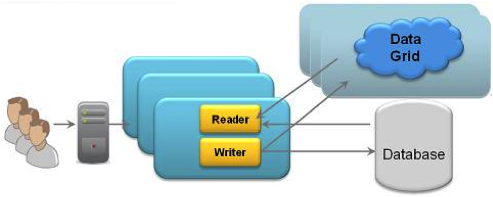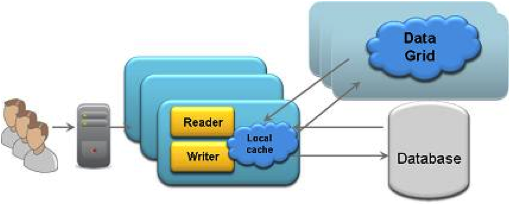Spring Cache Abstraction with XAP
| Author | XAP Version | Last Updated | Reference | Download |
|---|---|---|---|---|
| Ali Hodroj Director of Solution Architecture GigaSpaces |
9.7 | October 2014 | Spring Framework | Github link |
Introduction
Since version 3.1, the Spring Framework provides support for transparently adding caching to an existing Spring application through method annotations. As is the case with transaction support, the caching abstraction decouples caching implementation from the business logic. This article shows how to utilize the XAP CacheManager with Spring that implements the following distributed caching scenario:
| Distributed cache | Distributed cache + local cache |
|---|---|
 |
 |
Benefits when using XAP as a Spring caching provider
- Decreased Latency – Ability to utilize local cache across all server instances for localized reads, greatly reducing serialization across the wire
- Scalability – Horizontally scalable and partitioned cache with flexible cache entry routing
- High Availability – Each partition has a backup instance deployable on a different JVM, host, or availability zone.
Configuring the Cache Storage
The XAP cache manager is located under org.openspaces.cacheable package. To use it, you simply declare the GigaSpacesCacheManager as the cacheManager bean. In addition, the “space” property must be set to specify the URI of the XAP cache.
<cache:annotation-driven />
<bean id="cacheManager" class="org.openspaces.cacheable.GigaSpacesCacheManager">
<property name="space" value="jini://*/*/space" />
</bean>
Declarative Annotation-based Caching
Spring provides two annotations for caching declaration and eviction: @Cacheable and @CacheEvict. The @Cacheable annotation will trigger a cache put, while @CacheEvict will clear all space entries associated with a given cache:
@Cacheable("books")
public Book findBook(ISBN isbn) {...}
@CacheEvict(value = "books", allEntries=true)
public void loadBooks(InputStream batch)
Data-locality with a local cache (highest performance)
Since most cache queries in Spring are ID-based lookups, the performance can be dramatically improved by utilizing the Local Cache feature of XAP.
Here is an example how to configure the Local Cache:
<cache:annotation-driven />
<bean id="cacheManager" class="org.openspaces.cacheable.GigaSpacesCacheManager">
<property name="space" value="jini://*/*/space" />
<property name="localCache" value="true" />
</bean>
